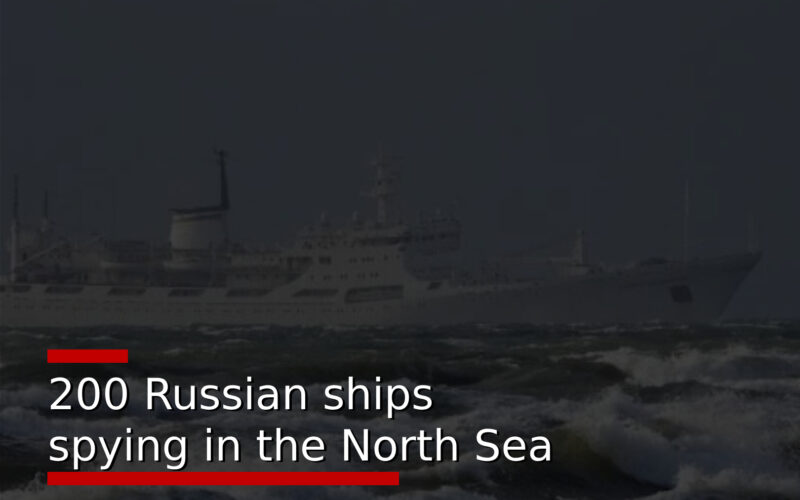Nearly 200 Russian civilian vessels are trying to gather intelligence on the location of essential cables and pipelines at the seabed of the North Sea in order to potentially sabotage or disrupt them. The North Sea is of critical importance for European countries, with data, power and communication cables, as well as oil and gas pipelines running on the seabed.
For this activity Moscow uses fishing boats, cargo ships, oil tankers, research vessels and pleasure yachts to do so. There were 1,012 Russian-flagged ships active in the North Sea over the past decade; almost 60,000 times they hung around seemingly aimlessly; 950 times within 1 kilometre of cables or pipelines. 167 civilian Russian vessels were involved.
In recent months, Russian military research vessels have repeatedly been suspected of sabotage. The Russian research vessel Admiral Vladimirsky has frequently been spotted in European ports and caught behaving abnormally, while navy spy ship Yantar made international headlines ever since it went into service in 2015 for its capacity to target underwater infrastructure. The Yantar carries submarines on board that are allegedly used for maintenance and repairs below the surface, but that are capable of cutting cables at a depth of several kilometres.
Late last month a Russian submarine was suspected of navigating in Irish waters. Concerned about potential sabotage of cables and pipelines, France, Norway and the United Kingdom helped the country, which doesn’t have the military capacity to do so, hunt the vessel.
These aren’t isolated incidents: while the ships have been facing increased scrutiny since Russian President Vladimir Putin ordered the full-scale invasion of Ukraine in 2022, Russia has been seeking to spy on the locations of cables and pipelines, with the potential to disrupt data and energy exchanges, for years. Since 2014, the country has been deploying an increasing number of civilian vessels to scour the North Sea.
“Authorities have found listening devices on fishing vessels,” said political scientist at the University of Copenhagen Mariia Vladymyrova, who has spent years researching Russia’s activities. “This tactic is not new. It was also used during the Cold War, but since 2014 we have seen a clear increase.” The investigation found 1,012 Russian-flagged ships that have been active on the North Sea between 1 January 2014 and 1 April 2024: fishing boats, cargo ships, yachts, oil tankers, and scientific research vessels.
Read also: UK Foreign Minister: we must hunt the Russian shadow oil tanker fleet
“Russian ships are suspicious in themselves, even if they maintain a very normal sailing pattern. Because every Russian ship, even if it works for a private company, works for the Russian government anyway,” said Thomas De Spiegelaere, spokesman for the Maritime Security Cell of the Belgian Federal Public Service of Mobility and Transport.
Russia makes no secret of using commercial ships for military purposes. After the invasion of Ukraine, Putin tightened its Maritime Doctrine. The updated code, which defines the objectives of the Russian navy, now says that civilian vessels, including fishing boats and transport ships, are of “strategic importance for increasing maritime preparedness” and may be used for “special operations carried out by the armed forces of the Russian Federation”. Sailors are trained in advance for this purpose and their ships are adapted if necessary, according to the code. Russia does this to expand its capacity to surveil European infrastructure under the sea, political scientist Vladymyrova said.
Maritime services also see Russian merchant ships sail through the North Sea – mainly from the Baltic Sea towards the Mediterranean of Black Sea – under the escort of Russian military ships more and more frequently, De Spiegelaere said. Fishing boats and transport ships may be used for “special operations carried out by the armed forces of the Russian Federation”. But even without a military escort, Russian ships are regularly suspect.
Read also: EU ageed on 14th sanctions package against Russia.
Russian ships are monitored from the moment they enter the North Sea countries’ Exclusive Economic Zones (EEZ), an area between some 22 kilometres and 370 kilometres from shore. This is done using an automatic identification system (AIS) – a location signalling system that is installed on the ships themselves – and software that monitors the movements of ships and predicts routes and arrival times.
One of the tell-tale signs of clandestine activity is when the AIS equipment is switched off and the ship drops off the radar, reappearing somewhere completely different a few days later. Then there are other questionable behaviours, such as deviating from their shipping routes or slowing down without apparent reasons. That’s suspicious because they don’t make economic sense: they’re more expensive because more fuel is needed and crews have to be paid for longer, according to De Spiegelaere.
One such case is that of the Arctic Spirit, which, in June 2019, sailed on a straight course in the North Sea between Denmark and the United Kingdom, but then started drifting over data cables for several hours in between.
Read also: U.S. restrictions allows Russia to keep in safe planes that drop deadly glide bombs
One possible reason is that ships have to slow down when they want to deploy underwater drones, as the latter can only handle a speed of some 3 to 5 knots (about 5.6 to 9.26 km/h) – down from the usual speed of 20 knots (about 37 km/h). These events become especially suspicious when they take place near critical infrastructure: gas and oil pipelines, wind farms, data cables. (Russia also seems to keep a close eye on NATO exercises – there is always one or two Russian ships sailing nearby.)
One of the civilian Russian ships that made such suspicious manoeuvres over European infrastructure is the Sirius. Built in 1978, the 87-metre-long refrigerated cargo ship is owned by Russian company Norebo. Its home port is Murmansk, which is also a major naval base. In 2022, for example, the Sirius and the Atlantic Lady, another cargo ship, seem to aimlessly sail up and down part of the Dutch coast, crossing numerous telecommunications cables before entering port. The Sirius is known to Western security services primarily for possible smuggling and violating sanctions, according to the Belgian Maritime Cell, but such a manoeuvre also points to possible espionage.








